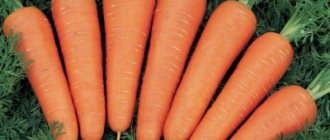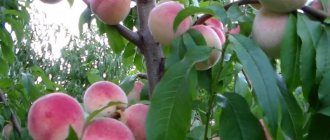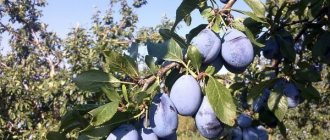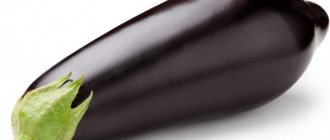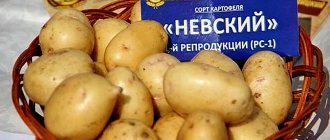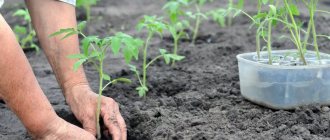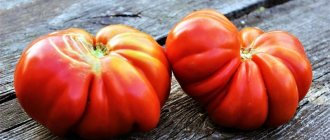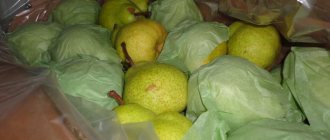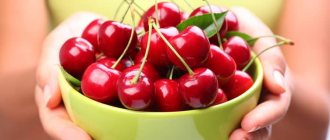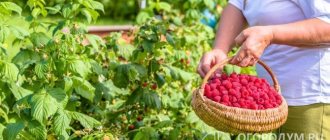Pepper with the self-explanatory name Hercules is distinguished by its cold resistance and immunity to diseases characteristic of the culture. The variety appeared thanks to the work of domestic breeders; it is suitable for cultivation in central Russia, the Urals, and Siberia. It is universal in use and can be stored for a long time.
Our article contains a description of Hercules sweet pepper, its characteristics, features and productivity indicators.
What type of pepper is this?
Mid-season crop: you will receive the first harvest 100 days after the appearance of the first shoots. Hercules is planted in seedlings: this way it shows the best yield.
Peculiarities
The bushes are compact, reaching 50 cm in length. The foliage is dark green, the leaves are medium-sized and oblong.
The recommended planting density for Hercules is 50x40.
Fruit characteristics and yield
The fruits are cube-shaped and slightly flattened. The peel is glossy bright red. Vegetable weight - from 150 to 300 g.
The wall thickness is 8 mm, so the crop tolerates transportation well over long distances.
The pulp is sweet, crispy, juicy, and there are few seeds. The yield is stable: about 3 kg is harvested from 1 bush.
Interesting ! 100 g of bell pepper contains 25 kcal. The vegetable strengthens the immune system and prevents vision problems. The fruits are rich in vitamins A, B, C, food acids, and antioxidants.
Characteristic
The harvest from late-ripening Hercules will have to wait a long time - at least 120-130 days from the moment the first shoots appear. The harvest is bountiful, there are a lot of fruits, they fit tightly around the bush.
Hercules pepper is characterized by resistance to unfavorable growing conditions and sets fruit well. The bush is not afraid of alternating cold weather, dry and wet weather.
Hercules resists well many common diseases, for example, fusarium. He is not afraid of the tobacco mosaic virus, which can leave a gardener without a harvest.
The main characteristics are presented in the table.
| Characteristic | Index |
| Ripening period | Late ripening |
| Maturation period | 130 days |
| Fruit color | In technical ripeness - dark green, in biological ripeness - bright red |
| Plant height | 0.7 m |
| Productivity | 2.6-3.5 kg per sq.m. |
| Wall thickness | 7 mm |
| Fruit weight | 160 g, maximum – 300 g. |
| Fruit size | Length 12 cm, width – 11 cm |
| Number of cameras | 3-4 |
| Ribbing | Mild |
| Disease resistance | Highly resistant to Fusarium wilt and tobacco mosaic |
| Growing region | Everywhere |
| Suitability for storage and transportation | High |
| Use of fruits | Universal |
The fruits of Hercules are good in fresh, vitamin-rich salads, and after heat treatment - in soups, side dishes and main dishes - they retain their color and aroma.
Pepper Hercules
Preparation for cultivation
Preliminary procedures include disinfection of seeds, preparation of seedling soil and beds. Let's look at each stage in detail:
- Seed disinfection protects plants from diseases and pests. The grains are disinfected with aloe juice, Bordeaux mixture or succinic acid solution. Heating in the oven for 1 hour is used as disinfection: the high temperature kills pathogens on the surface of the seeds.
- Germination of seed material. The grains are wrapped in damp, warm gauze and placed on the windowsill. After a few days, the first shoots appear. Germination strengthens the plant’s immunity; the stimulator “Kornevin” is added to accelerate growth.
- Preparing seedling soil. It is recommended to use a mixture of soil from the garden and biosoil from the store. The soil is taken in equal parts, sand, sawdust, peat and humus are added to it. The resulting composition is watered with a weak solution of potassium permanganate.
- Preparation of beds begins in autumn. The best predecessors for peppers are cabbage, carrots, and legumes. The soil is dug up using a shovel handle and cleared of weeds, debris and leaves. For the winter, a solution of liquid mullein is added to the beds. From mid-March, the beds are dug up again and loosened with a pitchfork.
Planting seeds
Pepper seeds Hercules
Hercules is grown in seedlings. It is best to plant seeds in March. All planting material is soaked in a weak solution of manganese and kept there for about fifteen minutes. The seeds are dried and sown in containers filled with fertilized soil mixture. For sowing, it is recommended to use cassettes or peat pots.
Conditions for growing seedlings
To create a greenhouse effect, the containers must be covered with cellophane or a piece of glass so that the seeds begin to germinate as quickly as possible. The soil is moistened from time to time.
As soon as the first shoots appear, mineral supplements can be applied . Young seedlings are transferred to a cooler room, hardening begins a couple of weeks before transplanting into unprotected soil.
Transplantation into open ground
It is best to do this at the end of May, when warm weather sets in and the soil composition warms up. The planting scheme is forty by sixty centimeters so that the plants do not interfere with each other’s development.
It is necessary to choose a place for planting carefully, since Hercules feels best in light, fertile areas that are well lit and ventilated.
Growing seedlings
Seedlings are prepared at the end of March. To do this, purchase containers - cassettes, pots, tablets, cups. You can grow the crop in ordinary plastic cups or kefir bags. The main thing is to rinse them thoroughly with warm water and soda.
The procedure for planting and caring for a crop looks like this:
- Soil is poured into the container. At a distance of 10 cm from each other, using a pencil, make grooves 1 cm deep.
- Place 2 seeds in each hole, sprinkle soil on top and water with warm water.
- Subsequently, the soil is moistened as it dries, approximately once every 4 days.
- With the appearance of the first shoots, the seedlings are fertilized with liquid bird droppings.
- Store the bushes on a warm, sunny windowsill. Daylight hours for seedlings are at least 12 hours.
Growing seedlings with picking
Picking - transplanting seedlings into larger containers. It is necessary if the plants were previously planted in cups or pots. In such conditions, the roots do not have enough space to develop and more space is required. Plant the sprouts carefully so as not to damage the fragile root system. To do this, prepare containers and soil in advance.
Advice. Peppers do not like picking, so it is better to plant them immediately in individual containers.
Landing
7–10 days before planting the crop in the garden, watering is stopped. The best time for picking is early morning or evening. Holes are prepared in the beds and water is poured into them.
The seedlings are removed from the containers, placed in holes, and the base of the stem is slammed down with soil. To protect against frost, the sprouts are covered with film or thin glass for the first 7 days.
Further care
Care consists of regular watering and fertilizing. Moisten the beds every 5–7 days. About 1 liter is consumed per bush. The water should be warm and clean. The stream is directed directly to the root. The optimal time for irrigation is morning or evening to avoid sunburn.
Feed Hercules pepper 3-4 times per season. For this, organic and mineral fertilizers are used: ash, ammonium nitrate, iodine, Bordeaux mixture, superphosphate. Apply funds before watering. The interval between procedures is 10–15 days.
Important! The beds must be clean and well-groomed. Gardeners remove weeds and debris and loosen the soil once a week. Weeding makes the soil light and airy, which has a beneficial effect on the development of roots and stems.
Planting seedlings of Hercules pepper variety in open ground
Seedlings should be planted in open beds after night frosts have passed and the air temperature during the day is at least 15 degrees. This event is usually timed to coincide with the beginning of June. A common planting pattern is 40x60 cm. Pepper seedlings are moved to the greenhouse in the first ten days of May.
Place a tablespoon of any mineral complex fertilizer, for example, nitrophoska, into the hole. The seedlings are removed from cups containing a ball of earth, pre-watered with water, and immediately placed in the planting hole. They are filled with soil without strong compaction, making sure that the root neck of the pepper remains flush with the soil surface.
As they develop, at the stage of fruit formation, compact bushes of Hercules pepper still require garter, since the growing fruits can break the stems with their weight. Taking this into account, a support is installed next to the plants.
Features of cultivation and possible difficulties
When grown in a greenhouse, a special care regimen is required. Water the beds less frequently, about once a week. Indoor soil is characterized by high humidity and stuffiness, so it is important not to allow excess liquid. The structure is ventilated daily by opening the windows: fresh air is necessary for peppers to grow healthy.
When applying fertilizing, the dosage is observed: an excess or lack of minerals leads to diseases. For example, excessive application of nitrogen promotes the growth of green mass, while the fruits remain small and insipid. An excess of calcium and iron leads to yellowing and drying of the leaves.
Important! With the appearance of the first fruits, the bushes form. A few central shoots are left, the rest are cut off. This increases the number of large and juicy peppers. The plant does not need weak and thin shoots.
Care
Subsequent plant care differs little from traditional care and includes:
Watering. Since pepper is a moisture-loving plant, watering is carried out as the soil dries out - depending on the weather. Good results are obtained by using drip irrigation, in which moisture is supplied directly to the roots. Mulching. To protect the soil from drying out, as well as to control weeds, cover the soil around the peppers with mown grass, straw, and sawdust. Large farms use special synthetic materials for mulching that allow air and moisture to pass through. Weeding. When weeding, you should not loosen the soil around the plants to a great depth, since the roots are located quite close to the surface and can be damaged. Feeding. To obtain a bountiful harvest, plants need to be fed throughout the entire growing season. It is advisable to carry out the first fertilizing no earlier than a week after planting. Before the formation of ovaries, fertilize with green fertilizer - a diluted infusion of grass (in a ratio of 1:10), then proceed to fertilize with potassium and phosphorus fertilizers. The frequency of feeding is 2-3 times a month. It is advisable to fertilize after rain or watering, on damp soil. Garter. Pepper bushes are quite strong, but sometimes under the weight of the fruit, especially during the ripening period, the stems may not withstand the load. To avoid breaking the stems, they are tied to supports. Formation of bushes. To obtain a full harvest, gardeners pinch the tops of plants when their height reaches 15-20cm. All stepsons growing below the fork are also removed. Flowers and ovaries growing inside the bush are also removed. Plant Inspections
It is important to carefully examine the leaves and fruits of plants, so that if spots appear or growth inhibition occurs, take immediate action - remove diseased bushes, and carry out preventive spraying for healthy ones
If a greenhouse is used to grow peppers, it is necessary to provide ventilation in it, since humid air can cause many fungal diseases.
Since peppers in greenhouses usually grow taller than in open ground and can shade each other, they are planted more sparsely, and if they are very dense, some of the foliage is torn off.
During the hot season, the temperature in greenhouses often rises above 40 degrees. The peppers experience stress and as a result may lose color (fruit set does not occur). To prevent this, if possible, open the side walls of greenhouses or cover them from direct sunlight.
Hercules pepper is a variety that ripens in late summer - early autumn. In order to have time to collect the entire harvest that has started on the bushes, it must be limited - excess flowers or ovaries must be cut off. To increase the yield, peppers are harvested at the stage of technical maturity - green.
Greenhouses will allow you to harvest peppers right up to frost, especially since even harvested green peppers have a wonderful taste. The good keeping quality of the fruit allows the pepper to ripen and be stored for a long time.
Typical diseases and pests
Diseases and pests appear due to sudden climate changes, heat or rain, and improper care.
The most common and dangerous diseases are:
- Late blight is a fungal infection that occurs due to high humidity and heat. To prevent late blight, follow the rules of crop rotation, loosen the soil in a timely manner, and remove weeds. The fungus appears in the form of yellow and brown spots on the leaves, the fruits lose their elasticity and taste. The disease is treated with Quadris or Oksikhom.
- Powdery mildew is a virus that appears as a white coating on leaves and stems. Occurs due to contaminated soil, excessive application of mineral and organic fertilizers. For prevention, spraying with iodine or a solution of copper sulfate is used, for treatment - a solution of wood ash or “CHOM”.
Among the pests, wireworms, mole crickets and Colorado potato beetles are noted. Insects live underground and are frost-resistant. They destroy plants from the roots: they gnaw them, which is why the stem does not receive nutrients. Dry eggshells will prevent the appearance of pests: they are scattered over the beds. To get rid of insects, use “Typhoon” or “Hurricane” products.
Advantages and disadvantages of the variety
The advantages include attractive commercial qualities, juicy sweet pulp, and versatility of use. The Hercules variety is valued for its immunity and cold resistance. Tender fruits are suitable for preparing a wide variety of dishes. The thick walls of vegetables ensure long-term storage.
Important! Peppers are harvested in mid-to-late August, when they turn deep red with a glossy hue. The Hercules variety is used for canning, pickling, stuffing, stewing and drying. The sweetness of peppers combines with cucumbers, tomatoes, chicken and fish.
There are no disadvantages noted in the variety. Only occasionally does a crop suffer from late blight or powdery mildew due to improper care.
Pepper in a greenhouse: video
Among the numerous varieties of sweet peppers, the Hercules pepper stands out in a special way. Thanks to its external characteristics and excellent taste, this vegetable has become the favorite of a large number of gardeners.
It is difficult to list all its advantages, and according to my neighbor, a summer resident, this is almost the most productive and tasty variety of all that she had to plant. What is so good about “Hercules”, what are its distinctive features and characteristics? It is believed that it is incredibly resilient and can withstand not only cold weather, but also frost. In addition, its taste is noticeably different from other fruits. Let's try to look at this variety in more detail.
Reviews
Despite the popularity of Hercules, some gardeners were disappointed with the harvest. Let's look at a few reviews:
Evgeniy, Omsk: “The Hercules variety was planted for the first time. Based on reviews, I thought that the pepper was easy to care for, but I had to constantly remove the side shoots. I rate the taste as “average”, I expected much more.”
Irina, Chelyabinsk: “I’ve been planting Hercules bell pepper for a long time. I’m always happy with the harvest: the peppers grow large and sweet. The variety is resistant to weather changes, frosts and winds.”
Ksenia, Moscow: “I love bell peppers. I especially like the Hercules variety. I plant seedlings, the harvest is rich. I use it fresh, and freeze some of it for the winter, after chopping it first.”
